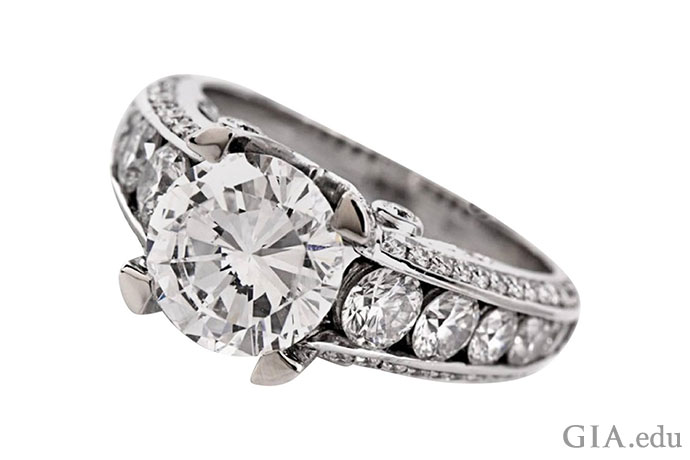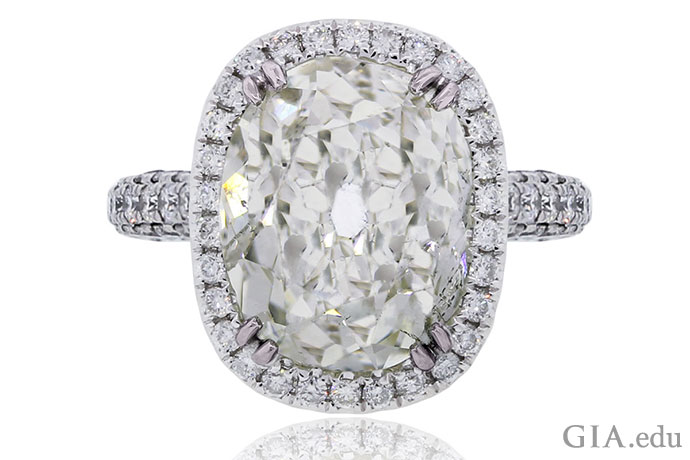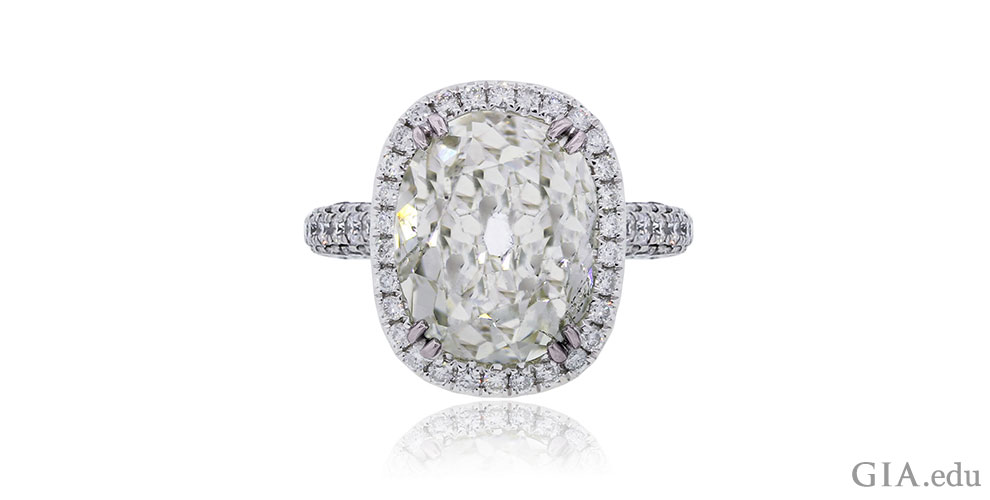Comparing loose diamonds for an engagement ring? Don’t be dismayed by the dizzying array of choices. The important thing is understanding how to compare loose diamonds. Here are six easy steps to help you pick a diamond that’s beautiful and a smart purchase.
1. First things first: Establish a budget
Diamond engagement rings sell from less than $500 to more than $500,000. That’s quite a range, so it might be helpful to know that in 2017 the average U.S. consumer spent $6,351 on an engagement ring according to The Knot.
So what should your budget be? That is a question only you can answer. But knowing how much you want to spend before you start to look for an engagement ring diamond is essential. A budget is required when comparing the loose diamonds in your search, and it will help ensure that you’re comparing apples to apples, so to speak.

A 2.02 carat (ct) round brilliant set in a simple band is sure to leave your beloved breathless. Courtesy: 1stdibs.com
2. Learn the 4Cs
The 4Cs of Diamond Quality, which GIA created, is the universal standard for describing diamonds. Understanding the 4Cs will allow you to determine the diamond qualities that are most important to you and help you when you are comparing loose diamonds.
The 4Cs are:
- Color: Within the D-to-Z range, less color is rarer and more valuable.

GIA created the D-to-Z color scale, with D being colorless and Z showing distinct yellow, brown or gray. Within the D-to-Z scale, colorless diamonds are typically prized over ones with color. Intensely colored diamonds (fancy colors) are a different matter.
- Cut: How well a diamond’s facets interact with light is determined by the quality of its cut.

Three round brilliant cut diamonds with different cut grades vividly illustrate how cut affects a diamond’s appearance. Based on the GIA Diamond Cut Scale, the cuts of these diamonds were graded, from left to right: Poor, Good and Excellent. Photo: Kevin Schumacher/GIA
- Clarity: This refers to the presence or absence of inclusions in the stone and blemishes on the surface.
 Numerous inclusions and blemishes mar the appearance of this diamond. Photo: John I. Kiovula/GIA |
 An internally flawless diamond is a thing of beauty. Photo: Robert Weldon/GIA. Courtesy: Rogel & Co. Inc. |
- Carat Weight: The measurement, in metric carats, of how much a diamond weighs, its mass or size.

As a diamond’s carat weight increases, it typically appears larger.
3. When comparing loose diamonds, prioritize your most important C
Once you’ve set your budget and learned about the diamond quality factors, you can begin identifying which “C” is most important to you. This will help you understand how to compare loose diamonds even further, and you can start shopping in earnest.
Here’s a quick overview of the 4Cs and how to prioritize them:
-
- If a diamond’s colorlessness captivates you, then diamond color will be your most important C. Remember that a diamond’s color will be affected by the metal used in the ring. Platinum and other white metals can accentuate the absence of color in diamonds with a color grade of H or better. Similarly, diamonds with a slightly yellowish body color (a color grade lower than M) will be more noticeable if set in yellow gold.

GIA graded the 2.04 ct diamond center stone in this ring as F color, VVS2 clarity. Courtesy: 1stdibs.com
- If you want a diamond with fewer inclusions and blemishes, then clarity will be your most important C. Keep in mind that you are not likely to see inclusions in diamonds with clarity grades of SI1 or higher with the unaided eye.

Inclusions and blemishes are typically more easily seen with the unaided eye in emerald cut diamonds. It might be possible to see an SI1 inclusion in an emerald cut, but this one has a clarity grade of VS1, so it should be pleasing to the eye. Courtesy: Blue Nile
- If you want a diamond with lots of sparkle, then cut quality will be your most important C. Many trade professionals think cut is the most important of the 4Cs, as it produces brightness, fire and scintillation – or the play of light we’ve come to associate with diamonds.
- If you want the appearance of size, then carat weight will be your most important C. (You might also consider certain engagement ring settings that can make your diamond look bigger.)

This 10.09 ct old mine cut diamond, precursor to today’s modern cushion brilliant cut, should satisfy anyone enamored with carat weight. Courtesy: TrueFacet.com
4. How to compare loose diamonds using grading reports
Diamond grading reports are an invaluable tool for comparing loose diamonds, for they have information on a diamond’s 4Cs and more. A report will also tell you if a diamond is natural, laboratory-grown or has been treated to enhance its color or clarity. Knowing this information empowers you to buy with confidence.

GIA offers a variety of diamond grading reports to meet your needs.
IMPORTANT TIP #1: Only compare diamonds graded by the same lab. Different labs may have different grading standards. GIA has nine labs around the world that grade diamonds, and all of them adhere to the same strict grading standards. GIA will not issue reports on color- or clarity-enhanced diamonds where the enhancement is not permanent.
IMPORTANT TIP #2: While a grading report from a reputable laboratory will provide you with an objective assessment of a loose diamond’s quality, the report will not tell you what the diamond will look like in person. Color, clarity and cut grades represent ranges. So loose diamonds with the same grades on paper can look different when compared side-by-side. Visit a jeweler to compare loose diamonds in person, which leads to tip #5.
5. Comparing loose diamonds under different lighting conditions
Now that you’ve already identified your most important C and are looking at diamonds graded by the same lab, you’ve probably narrowed your search down to two or three loose diamonds. What next?
Look at the diamonds in four different lighting environments:
- Spot lighting only, but one where the lights are not overwhelming
- Diffused lighting — fluorescent lights that bounce light off a white ceiling are best
- Mixed — spot and diffused lighting with neither of the two overpowering the other
- Natural daylight — directly under the sun, or under the dappled shade of a tree that breaks up the diamond’s light
These four lighting environments will let you see how the diamond looks in a variety of conditions. Sparkle is one of the most prized qualities in a diamond, and this lighting test lets the stone strut its stuff.
6. Calculate carat prices for loose diamonds
Once you’ve narrowed down your selection, calculate and compare the prices of the loose diamonds to see where you’re getting the best value. You can do this by determining the price per carat for each stone. It just requires some simple math: Divide the price by the carat weight.
- A 1.43 carat diamond priced at $4,500: $4,500÷1.43 = $3,147 per carat
- A 1.39 carat diamond priced at $4,500: $4,500÷1.39 = $3,237 per carat
Know that diamond prices aren’t determined by weight alone. Diamonds are valued based on the combination of all their quality factors. So, before you start comparing prices for loose diamonds, make sure you’re comparing diamonds of near-equal carat weight and with similar color, clarity and cut grades.
Also be aware of how popular carat weights can affect price. These weights are sometimes referred to as “magic sizes” in the trade: 0.25 ct, 0.50 ct, 0.75 ct, 1.00 ct and so on. Because more individuals want diamonds weighing these sizes, they are generally more expensive than diamonds that weigh slightly less. For example, assuming all other quality characteristics are equal, a 1.02 ct diamond will be significantly more expensive than a 0.96 ct diamond – even though it is difficult to see the difference in size.

Prices for diamonds dramatically increase at magic sizes. Illustration: Peter Johnston/GIA
We hope these tips help you to learn how to compare loose diamonds that will thrill your beloved. And if you need a little extra help, you might want to learn some common engagement ring terms before heading off to your nearest jewelry store.
